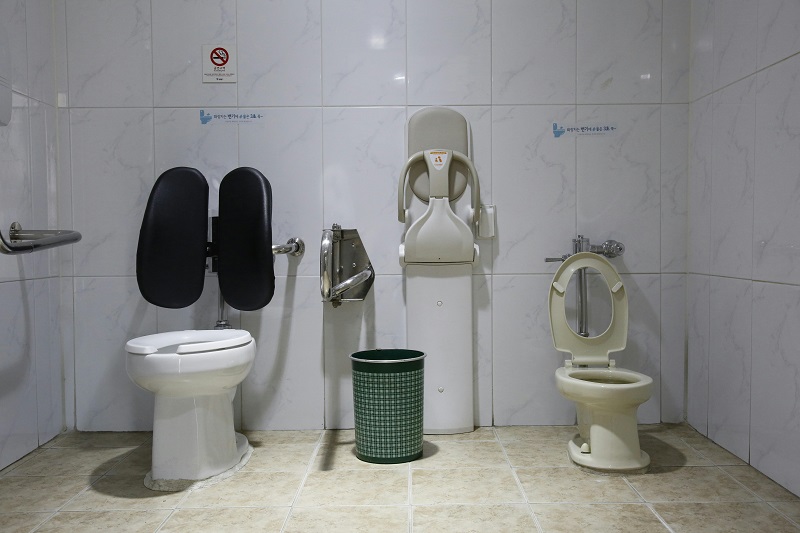Do you have plans to construct or upgrade a commercial bathroom space?
Meeting ADA standards serves to prevent legal problems while aiming to establish inclusive spaces that provide comfort and independence for all users. According to the CDC, the United States has 1 in 4 adults living with disabilities which underscores why accessible design has become essential.
But here’s the problem…
Business owners and contractors often overlook important ADA bathroom requirements which results in expensive future renovation work. With the number of ADA lawsuits rising annually proper compliance remains a crucial consideration that businesses cannot ignore.
This comprehensive guide provides complete information about ADA bathroom compliance by covering basic measurements and commonly missed details that can significantly improve accessibility.
What You’ll Discover:
- Why ADA Bathroom Compliance Matters
- Essential ADA Bathroom Measurements
- Critical Features for ADA-Compliant Bathrooms
- Common Compliance Mistakes to Avoid
- ADA Bathroom Compliance Checklist
- How to Verify Your Bathroom Meets Requirements
Why ADA Bathroom Compliance Matters
ADA bathroom compliance goes beyond legal obligations to focus on building spaces that include everyone. The Americans with Disabilities Act (ADA) became law in 1990 to guarantee equal access and opportunities for people with disabilities.
For businesses and public facilities, this means:
- Failing to meet ADA bathroom requirements exposes businesses to potential legal actions and monetary fines.
- Businesses have an ethical obligation to build environments which accommodate all potential visitors.
- In business terms accessibility means opening your establishment to the broadest group of people possible.
Bathroom accessibility must adhere to proper standards to ensure full functionality. Because all people need access to bathroom facilities these spaces become essential to perfect regarding accessibility requirements.
Before starting any bathroom construction or renovation, you should research the ADA requirements for bathrooms to ensure you’re creating a space that truly works for everyone. Applying the guidelines correctly during the initial phase helps prevent costly retrofitting in the future.
Essential ADA Bathroom Measurements
Precise measurements are fundamental to achieving ADA compliance. These dimensions represent the most crucial measurements you must understand.
Clear Floor Space
- A space with a 60 inches (152 cm) diameter is required for a wheelchair to achieve a half-circle turn.
- Each bathroom fixture needs to have at least 30 inches by 48 inches (76 cm by 122 cm) of open floor space available in front of it.
Door Requirements
- Doors must provide at least 32 inches (81 cm) of width when fully opened at a 90-degree angle.
- The required door maneuvering space should be at least 18 inches (46 cm) wide next to the door on its pulling side.
- Door hardware should function with one hand without requiring tight grasping or twisting motions.
Toilet Specifications
- The top of the toilet seat should be between 17 and 19 inches (43-48 cm) above the bathroom floor.
- The centerline distance from the side wall should measure between 16 and 18 inches (40-46 cm).
- Wall-hung toilets require clear floor space measuring at least 60 inches (152 cm) wide and 56 inches (142 cm) deep.
Sink Measurements
- The sink’s rim cannot exceed 34 inches (86 cm) in height from the ground.
- Required knee clearance space needs to measure at least 27 inches tall by 30 inches wide by 11 inches deep.
- A toe clearance of at least 9 inches (23 cm) height must extend a minimum of 6 inches (15 cm) back from the front edge
Grab Bar Specifications
- Side wall grab bar needs to have a length of at least 42 inches (107 cm) while being placed no more than 12 inches (30 cm) from the back wall
- The back wall grab bar needs to be 36 inches (91 cm) long and must stretch 12 inches (30 cm) from the toilet’s centerline towards the side wall.
- Gripping surfaces should be mounted between 33 to 36 inches (84 to 91 cm) above the floor.
Accurate measurement adherence is essential to meet compliance requirements. A one-inch deviation can render a bathroom inaccessible for someone who faces mobility challenges.
Critical Features for ADA-Compliant Bathrooms
Adequate bathroom accessibility depends on multiple essential features beyond fundamental measurements.
Grab Bars
The correct placement of grab bars ensures user safety and enhances mobility. They must be:
- Grab bars need to hold up under 250 pounds of force.
- Grab bars need to be installed at the exact locations and heights the ADA standards require.
- The ideal diameter for grab bars should range between 1¼ inches (3.2 cm) and 1½ inches (3.8 cm).
- A minimum space of 1½ inches (3.8 cm) between the grab bar and the wall is required for correct clearance.
Accessible Sinks and Faucets
- Faucets need to function with a single hand operation without requiring tight grip.
- Insulation or other protective configurations are required for hot water pipes to prevent contact injuries.
- The required clear floor space must be centered on the sink and extend at least 17 inches (43 cm) from the front edge.
- The lowest point of the mirror’s reflective surface should be situated at 40 inches (102 cm) or less from the floor level.
Accessible Dispensers and Accessories
- A forward approach requires a maximum reach distance of 48 inches (122 cm) for towel dispensers.
- The maximum reach for soap dispensers should not exceed 44 inches (112 cm) when approached from a parallel position.
- The toilet paper dispenser should be placed between 7-9 inches (18-23 cm) from the toilet and have a height ranging from 15-48 inches (38-122 cm).
Floor Surfaces
- Slip-resistant: All floor surfaces must be slip-resistant
- Surfaces must present no more than a ¼ inch (6.4 mm) vertical change unless protected with edge treatment.
- The maximum permitted slope in any direction must not exceed 1:48 ratios.
The combination of these features produces bathrooms that offer genuine accessibility beyond basic technical compliance.
Common Compliance Mistakes to Avoid
Despite good intentions many bathrooms do not conform to ADA standards because of these frequent mistakes.
1. Improper Toilet Compartment Size
Many bathroom designs show inadequate toilet compartment space as a common problem. Accessible compartments need to be 60 inches (152 cm) wide but designers often neglect to make space for transfer movements.
2. Incorrect Grab Bar Placement
The placement of grab bars requires precision to ensure their effectiveness. Common errors include:
- Installing them at the wrong height
- Incorrect positioning relative to the toilet
- The walls lack proper reinforcement to support weight requirements.
3. Sink and Mirror Height Issues
A number of installations fail to make sinks wheelchair accessible because they mount mirrors too high and fail to provide sufficient knee clearance underneath them.
4. Door Clearance Problems
Doors that need excessive force to open beyond 5 pounds of force remain non-compliant due to compromised maneuvering space or inaccessible hardware.
5. Obstructed Reach Ranges
The accessibility of dispensers, switches, or controls becomes impossible for many disabled people when they are positioned beyond the reach range of 15-48 inches for forward access.
6. Inadequate Signage
Restroom signs that meet ADA standards need to display tactile characters and Braille while following specific mounting height and location guidelines.
7. Protruding Objects
Circulation paths between 27-80 inches above the floor become dangerous when objects extend more than 4 inches (10 cm) into these areas for visually impaired individuals.
By steering clear of widespread retrofitting errors you can prevent substantial losses of time and resources.
The Bottom Line on ADA Compliance
Following ADA bathroom guidelines serves as a mandatory legal requirement while also opening doors to build spaces that embrace complete inclusivity. If you understand the detailed requirements and sidestep frequent design errors your bathroom designs will meet everyone’s needs.
Remember:
- The official ADA Standards remain the definitive source for the latest compliance requirements
- Every minor detail significantly impacts bathroom accessibility.
- Proper planning prevents costly retrofitting
- Meeting minimum standards through compliance means a lot more than just following rules because it actually provides dignity and independence to every person who uses the space.
This guide helps you move forward toward building bathrooms that comply with regulations and meet the accessibility needs of all users.










Leave a Reply